radiator JEEP GRAND CHEROKEE 2016 WK2 / 4.G SRT User Guide
[x] Cancel search | Manufacturer: JEEP, Model Year: 2016, Model line: GRAND CHEROKEE, Model: JEEP GRAND CHEROKEE 2016 WK2 / 4.GPages: 723, PDF Size: 5.54 MB
Page 643 of 723
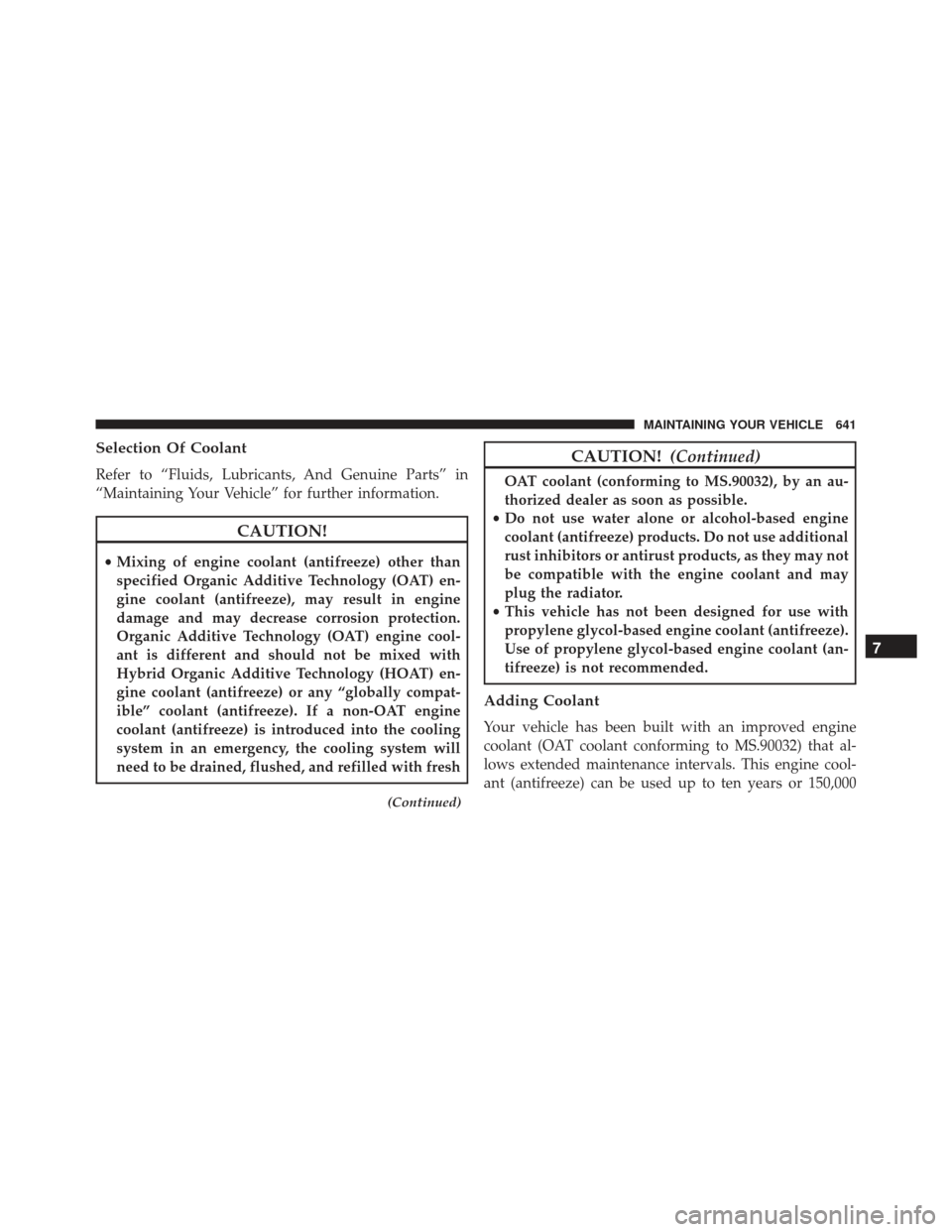
Selection Of Coolant
Refer to “Fluids, Lubricants, And Genuine Parts” in
“Maintaining Your Vehicle” for further information.
CAUTION!
•Mixing of engine coolant (antifreeze) other than
specified Organic Additive Technology (OAT) en-
gine coolant (antifreeze), may result in engine
damage and may decrease corrosion protection.
Organic Additive Technology (OAT) engine cool-
ant is different and should not be mixed with
Hybrid Organic Additive Technology (HOAT) en-
gine coolant (antifreeze) or any “globally compat-
ible” coolant (antifreeze). If a non-OAT engine
coolant (antifreeze) is introduced into the cooling
system in an emergency, the cooling system will
need to be drained, flushed, and refilled with fresh
(Continued)
CAUTION! (Continued)
OAT coolant (conforming to MS.90032), by an au-
thorized dealer as soon as possible.
• Do not use water alone or alcohol-based engine
coolant (antifreeze) products. Do not use additional
rust inhibitors or antirust products, as they may not
be compatible with the engine coolant and may
plug the radiator.
• This vehicle has not been designed for use with
propylene glycol-based engine coolant (antifreeze).
Use of propylene glycol-based engine coolant (an-
tifreeze) is not recommended.
Adding Coolant
Your vehicle has been built with an improved engine
coolant (OAT coolant conforming to MS.90032) that al-
lows extended maintenance intervals. This engine cool-
ant (antifreeze) can be used up to ten years or 150,000
7
MAINTAINING YOUR VEHICLE 641
Page 645 of 723
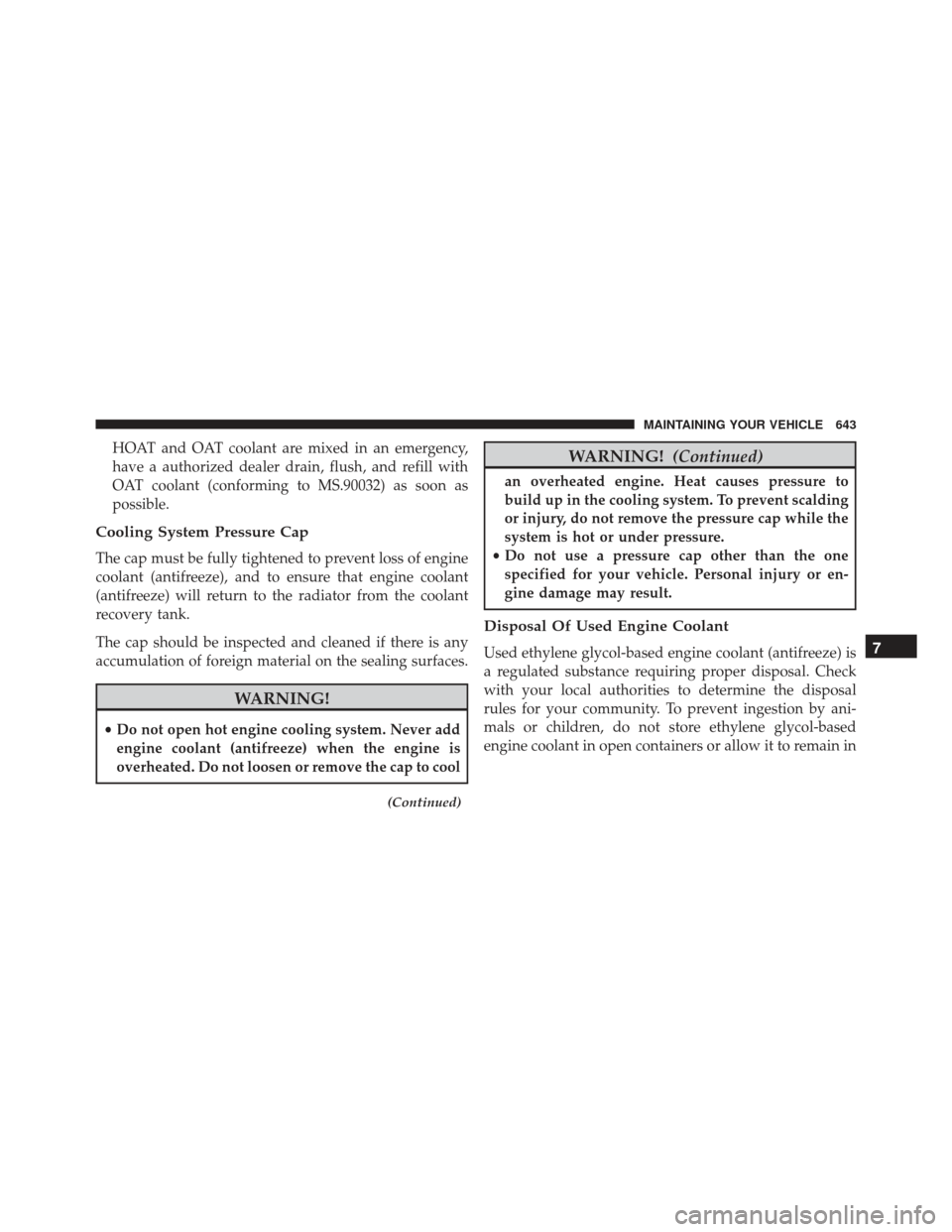
HOAT and OAT coolant are mixed in an emergency,
have a authorized dealer drain, flush, and refill with
OAT coolant (conforming to MS.90032) as soon as
possible.
Cooling System Pressure Cap
The cap must be fully tightened to prevent loss of engine
coolant (antifreeze), and to ensure that engine coolant
(antifreeze) will return to the radiator from the coolant
recovery tank.
The cap should be inspected and cleaned if there is any
accumulation of foreign material on the sealing surfaces.
WARNING!
•Do not open hot engine cooling system. Never add
engine coolant (antifreeze) when the engine is
overheated. Do not loosen or remove the cap to cool
(Continued)
WARNING! (Continued)
an overheated engine. Heat causes pressure to
build up in the cooling system. To prevent scalding
or injury, do not remove the pressure cap while the
system is hot or under pressure.
• Do not use a pressure cap other than the one
specified for your vehicle. Personal injury or en-
gine damage may result.
Disposal Of Used Engine Coolant
Used ethylene glycol-based engine coolant (antifreeze) is
a regulated substance requiring proper disposal. Check
with your local authorities to determine the disposal
rules for your community. To prevent ingestion by ani-
mals or children, do not store ethylene glycol-based
engine coolant in open containers or allow it to remain in7
MAINTAINING YOUR VEHICLE 643
Page 646 of 723
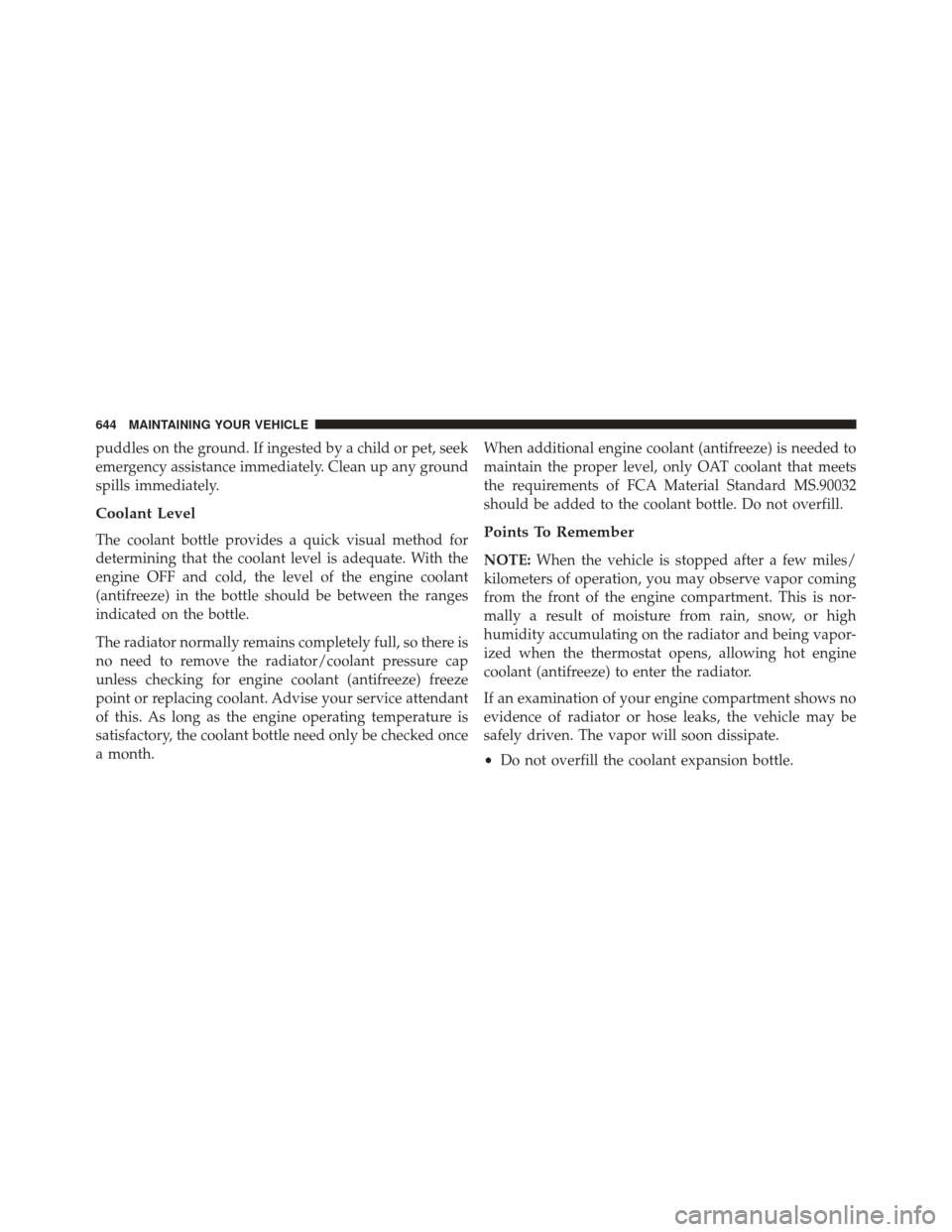
puddles on the ground. If ingested by a child or pet, seek
emergency assistance immediately. Clean up any ground
spills immediately.
Coolant Level
The coolant bottle provides a quick visual method for
determining that the coolant level is adequate. With the
engine OFF and cold, the level of the engine coolant
(antifreeze) in the bottle should be between the ranges
indicated on the bottle.
The radiator normally remains completely full, so there is
no need to remove the radiator/coolant pressure cap
unless checking for engine coolant (antifreeze) freeze
point or replacing coolant. Advise your service attendant
of this. As long as the engine operating temperature is
satisfactory, the coolant bottle need only be checked once
a month.When additional engine coolant (antifreeze) is needed to
maintain the proper level, only OAT coolant that meets
the requirements of FCA Material Standard MS.90032
should be added to the coolant bottle. Do not overfill.Points To Remember
NOTE:
When the vehicle is stopped after a few miles/
kilometers of operation, you may observe vapor coming
from the front of the engine compartment. This is nor-
mally a result of moisture from rain, snow, or high
humidity accumulating on the radiator and being vapor-
ized when the thermostat opens, allowing hot engine
coolant (antifreeze) to enter the radiator.
If an examination of your engine compartment shows no
evidence of radiator or hose leaks, the vehicle may be
safely driven. The vapor will soon dissipate.
• Do not overfill the coolant expansion bottle.
644 MAINTAINING YOUR VEHICLE
Page 647 of 723
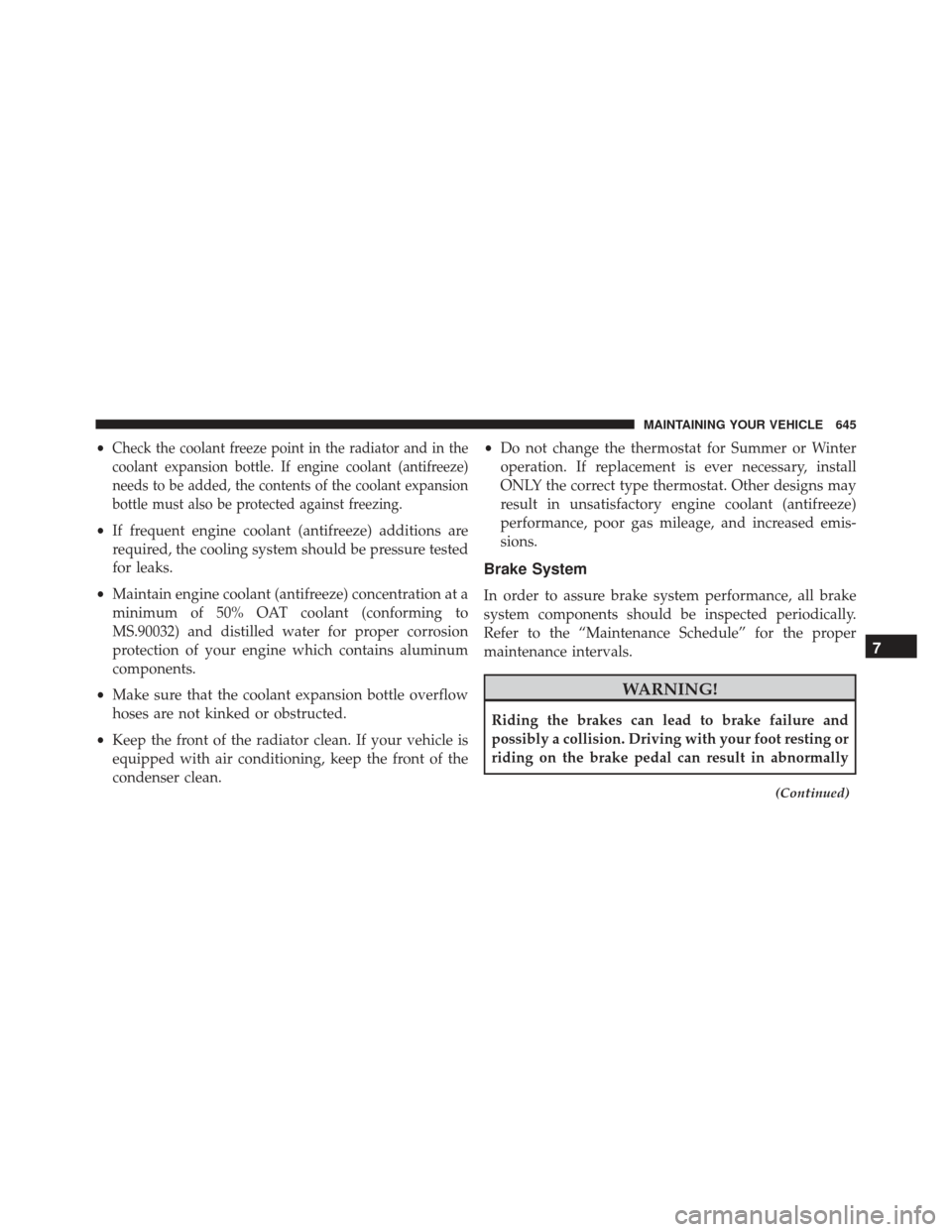
•Check the coolant freeze point in the radiator and in the
coolant expansion bottle. If engine coolant (antifreeze)
needs to be added, the contents of the coolant expansion
bottle must also be protected against freezing.
• If frequent engine coolant (antifreeze) additions are
required, the cooling system should be pressure tested
for leaks.
• Maintain engine coolant (antifreeze) concentration at a
minimum of 50% OAT coolant (conforming to
MS.90032) and distilled water for proper corrosion
protection of your engine which contains aluminum
components.
• Make sure that the coolant expansion bottle overflow
hoses are not kinked or obstructed.
• Keep the front of the radiator clean. If your vehicle is
equipped with air conditioning, keep the front of the
condenser clean. •
Do not change the thermostat for Summer or Winter
operation. If replacement is ever necessary, install
ONLY the correct type thermostat. Other designs may
result in unsatisfactory engine coolant (antifreeze)
performance, poor gas mileage, and increased emis-
sions.
Brake System
In order to assure brake system performance, all brake
system components should be inspected periodically.
Refer to the “Maintenance Schedule” for the proper
maintenance intervals.
WARNING!
Riding the brakes can lead to brake failure and
possibly a collision. Driving with your foot resting or
riding on the brake pedal can result in abnormally
(Continued)
7
MAINTAINING YOUR VEHICLE 645
Page 660 of 723
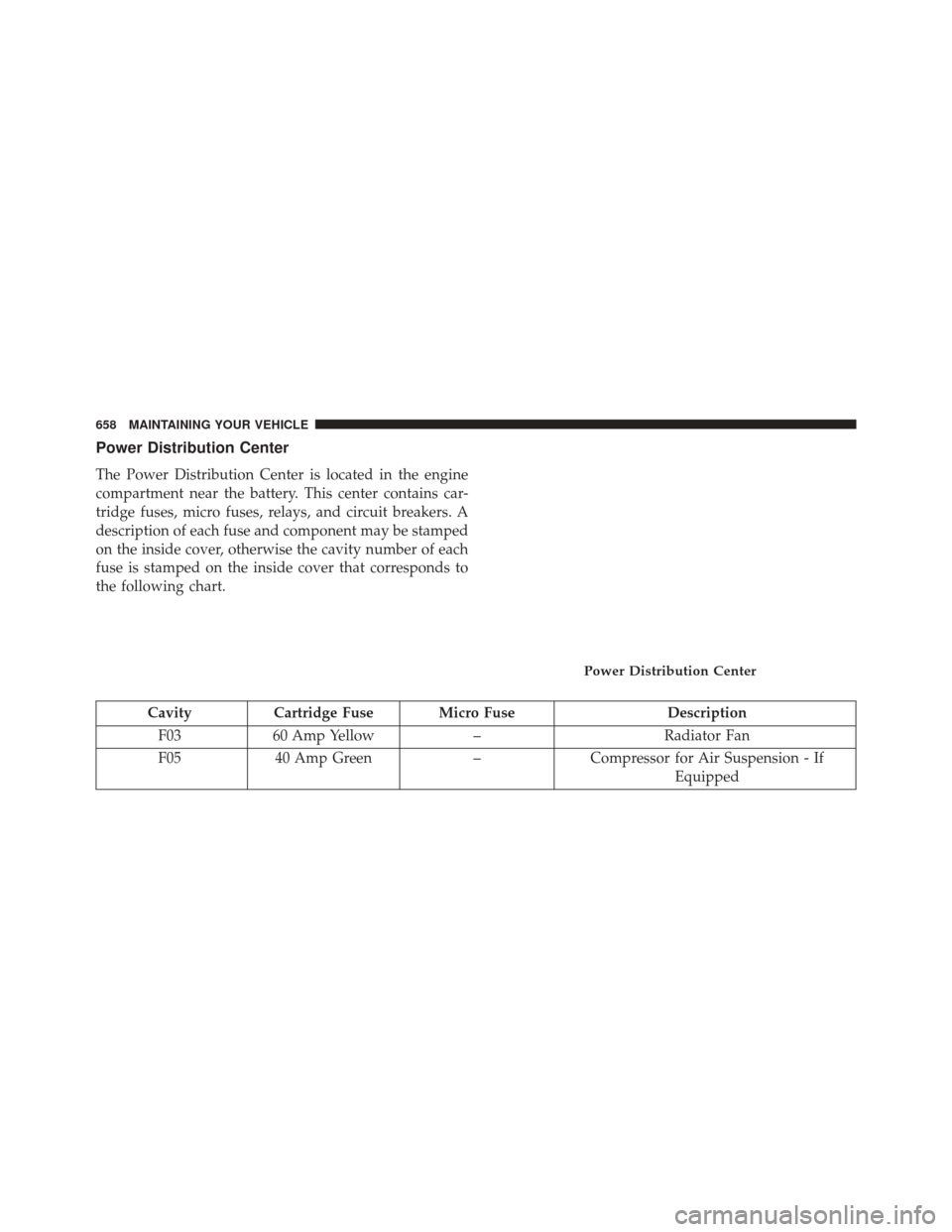
Power Distribution Center
The Power Distribution Center is located in the engine
compartment near the battery. This center contains car-
tridge fuses, micro fuses, relays, and circuit breakers. A
description of each fuse and component may be stamped
on the inside cover, otherwise the cavity number of each
fuse is stamped on the inside cover that corresponds to
the following chart.
CavityCartridge Fuse Micro Fuse Description
F03 60 Amp Yellow –Radiator Fan
F05 40 Amp Green –Compressor for Air Suspension - If
Equipped
Power Distribution Center
658 MAINTAINING YOUR VEHICLE
Page 704 of 723
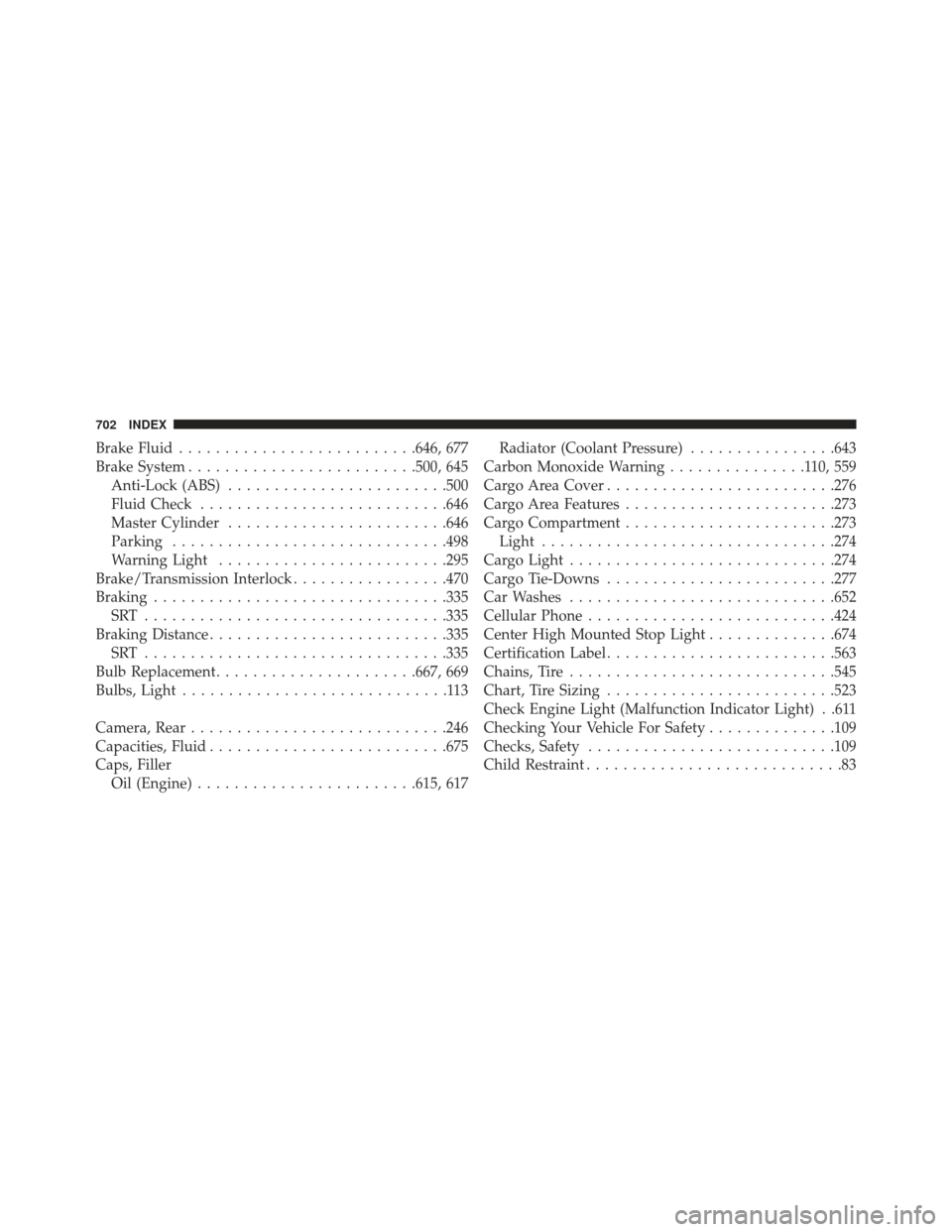
Brake Fluid......................... .646, 677
Brake System ........................ .500, 645
Anti-Lock (ABS) ....................... .500
Fluid Check .......................... .646
Master Cylinder ....................... .646
Parking ............................. .498
Warning Light ........................ .295
Brake/Transmission Interlock .................470
Braking ............................... .335
SRT ................................ .335
Braking Distance ......................... .335
SRT ................................ .335
Bulb Replacement ..................... .667, 669
Bulbs, Light .............................113
Camera, Rear ........................... .246
Capacities, Fluid ......................... .675
Caps, Filler Oil (Engine) ....................... .615, 617Radiator (Coolant Pressure)
................643
Carbon Monoxide Warning ...............110,559
Cargo Area Cover ........................ .276
Cargo Area Features ...................... .273
Cargo Compartment ...................... .273
Light ............................... .274
Cargo Light ............................ .274
Cargo Tie-Downs ........................ .277
Car Washes ............................ .652
Cellular Phone .......................... .424
Center High Mounted Stop Light ..............674
Certification Label ........................ .563
Chains, Tire ............................ .545
Chart, Tire Sizing ........................ .523
Check Engine Light (Malfunction Indicator Light) . .611
Checking Your Vehicle For Safety ..............109
Checks, Safety .......................... .109
Child Restraint ............................83
702 INDEX
Page 705 of 723
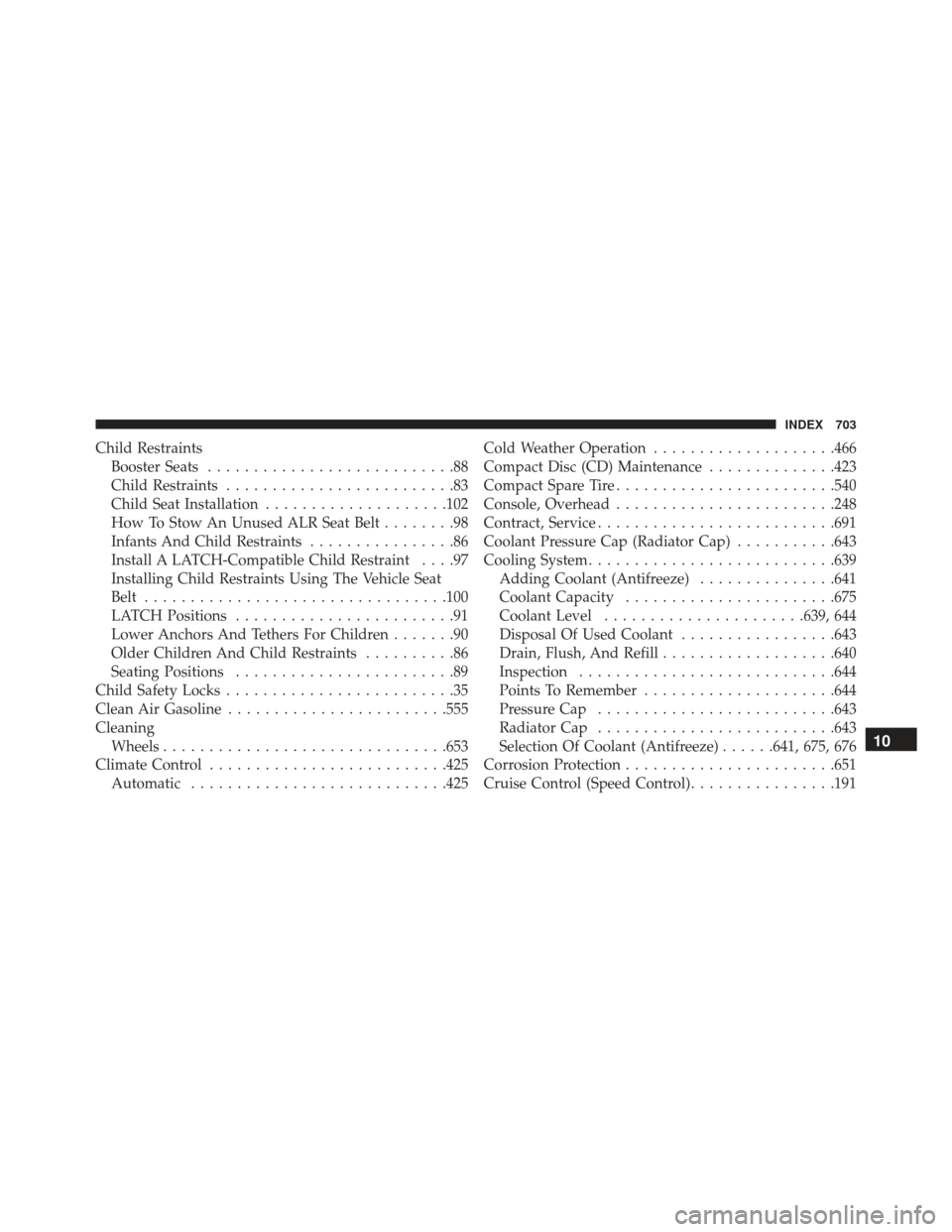
Child RestraintsBooster Seats ...........................88
Child Restraints .........................83
Child Seat Installation ....................102
How To Stow An Unused ALR Seat Belt ........98
Infants And Child Restraints ................86
Install A LATCH-Compatible Child Restraint ....97
Installing Child Restraints Using The Vehicle Seat
Belt ................................ .100
LATCH Positions ........................91
Lower Anchors And Tethers For Children .......90
Older Children And Child Restraints ..........86
Seating Positions ........................89
Child Safety Locks .........................35
Clean Air Gasoline ....................... .555
Cleaning Wheels .............................. .653
Climate Control ......................... .425
Automatic ........................... .425Cold Weather Operation
....................466
Compact Disc (CD) Maintenance ..............423
Compact Spare Tire ....................... .540
Console, Overhead ....................... .248
Contract, Service ......................... .691
Coolant Pressure Cap (Radiator Cap) ...........643
Cooling System .......................... .639
Adding Coolant (Antifreeze) ...............641
Coolant Capacity ...................... .675
Coolant Level ..................... .639, 644
Disposal Of Used Coolant .................643
Drain, Flush, And Refill ...................640
Inspection ........................... .644
Points To Remember .....................644
Pressure Cap ......................... .643
Radiator Cap ......................... .643
Selection Of Coolant (Antifreeze) ......641, 675, 676
Corrosion Protection ...................... .651
Cruise Control (Speed Control) ................191
10
INDEX 703
Page 714 of 723
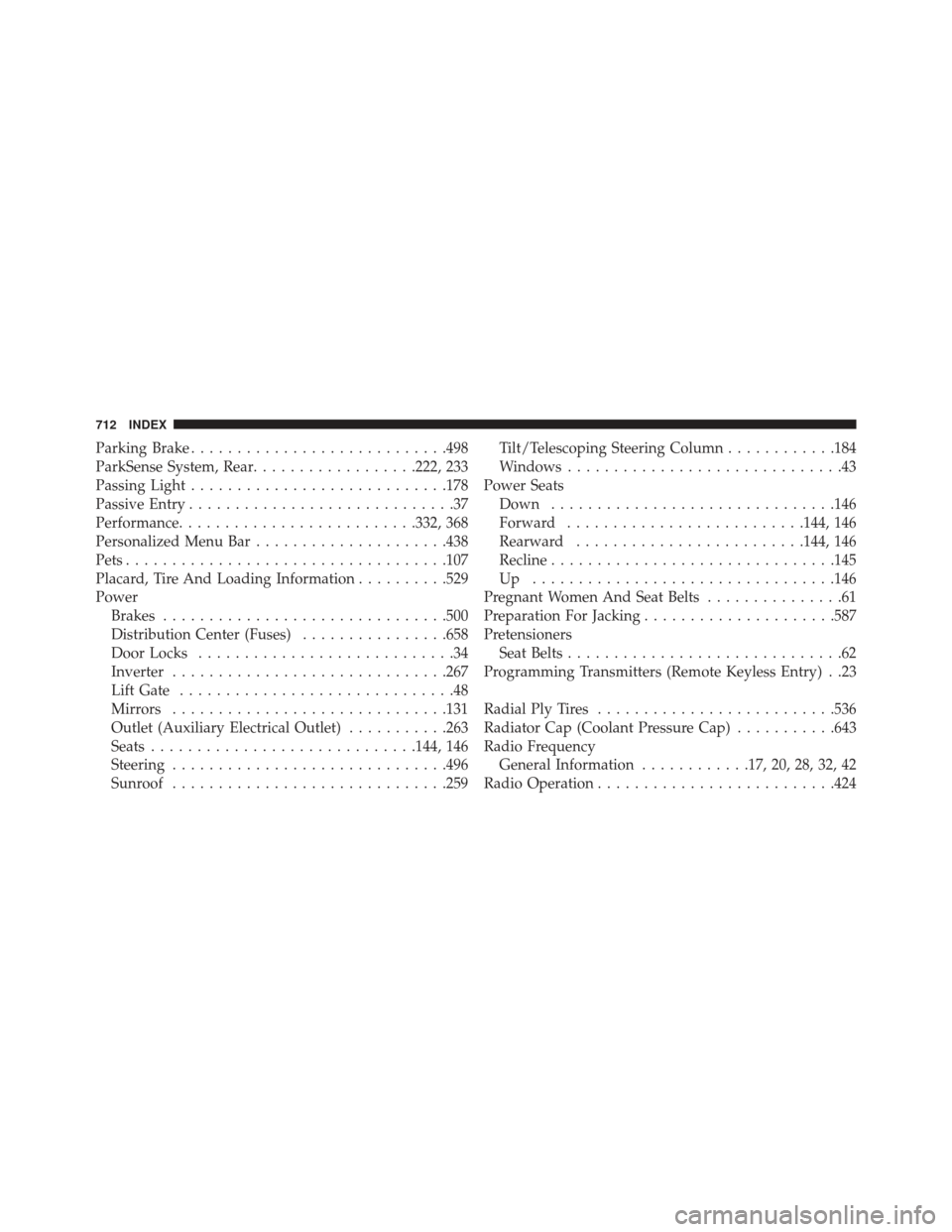
Parking Brake........................... .498
ParkSense System, Rear ..................222, 233
Passing Light ........................... .178
Passive Entry .............................37
Performance ......................... .332, 368
Personalized Menu Bar .....................438
Pets .................................. .107
Placard, Tire And Loading Information ..........529
Power Brakes .............................. .500
Distribution Center (Fuses) ................658
Door Locks ............................34
Inverter ............................. .267
Lift Gate ..............................48
Mirrors ............................. .131
Outlet (Auxiliary Electrical Outlet) ...........263
Seats ............................ .144, 146
Steering ............................. .496
Sunroof ............................. .259Tilt/Telescoping Steering Column
............184
Windows ..............................43
Power Seats Down .............................. .146
Forward ......................... .144, 146
Rearward ........................ .144, 146
Recline .............................. .145
Up ................................ .146
Pregnant Women And Seat Belts ...............61
Preparation For Jacking .....................587
Pretensioners Seat Belts ..............................62
Programming Transmitters (Remote Keyless Entry) . .23
Radial Ply Tires ......................... .536
Radiator Cap (Coolant Pressure Cap) ...........643
Radio Frequency General Information ............17, 20, 28, 32, 42
Radio Operation ......................... .424
712 INDEX